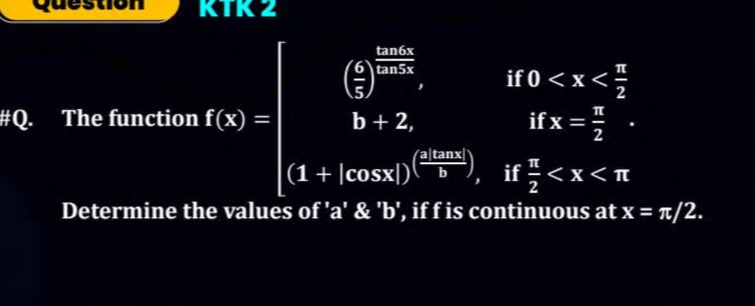Question
Question: The function $f(x) = \begin{cases} (\frac{6}{5})^{\frac{tan6x}{tan5x}}, & \text{if } 0 < x < \frac{\...
The function f(x)=⎩⎨⎧(56)tan5xtan6x,b+2,(1+∣cosx∣)(ba∣tanx∣),if 0<x<2πif x=2πif 2π<x<π
Determine the values of 'a' & 'b', if f is continuous at x = π/2.

a=0 and b=-1
Solution
For the function f(x) to be continuous at x=π/2, the following condition must hold: limx→(π/2)−f(x)=limx→(π/2)+f(x)=f(π/2)
-
Evaluate the left-hand limit (LHL): For 0<x<π/2, f(x)=(56)tan5xtan6x. Let x=2π−h, where h→0+ as x→(π/2)−. The exponent becomes: tan(5(2π−h))tan(6(2π−h))=tan(25π−5h)tan(3π−6h)=tan(2π−5h)tan(−6h)=cot(5h)−tan(6h) =1/tan(5h)−tan(6h)=−tan(6h)tan(5h) As h→0+, tan(kh)≈kh. So, the limit of the exponent is: limh→0+−tan(6h)tan(5h)=limh→0+−(6h)(5h)=limh→0+−30h2=0 Therefore, the LHL is: limx→(π/2)−f(x)=(56)0=1
-
Evaluate the right-hand limit (RHL): For π/2<x<π, f(x)=(1+∣cosx∣)ba∣tanx∣. Let x=2π+h, where h→0+ as x→(π/2)+. For x∈(π/2,π), cosx<0 and tanx<0. So, ∣cosx∣=−cosx=−cos(2π+h)=−(−sin(h))=sin(h). And ∣tanx∣=−tanx=−tan(2π+h)=−(−cot(h))=cot(h). The limit is of the indeterminate form 1∞. We use the formula limx→c(1+g(x))h(x)=elimx→cg(x)h(x). The limit of the exponent product is: limh→0+∣cosx∣⋅ba∣tanx∣=limh→0+sin(h)⋅ba⋅cot(h) =balimh→0+sin(h)⋅sin(h)cos(h)=balimh→0+cos(h)=ba⋅1=ba Therefore, the RHL is: limx→(π/2)+f(x)=ea/b
-
Evaluate the function value at x=π/2: f(π/2)=b+2.
-
Equate the limits and the function value for continuity: 1=ea/b=b+2 From the first equality, 1=ea/b: ba=ln(1)=0 This implies a=0, provided b=0.
Now, substitute ea/b=1 into the second equality: 1=b+2 b=1−2=−1 Since b=−1=0, our condition for a=0 is satisfied.
Thus, the values are a=0 and b=−1.
